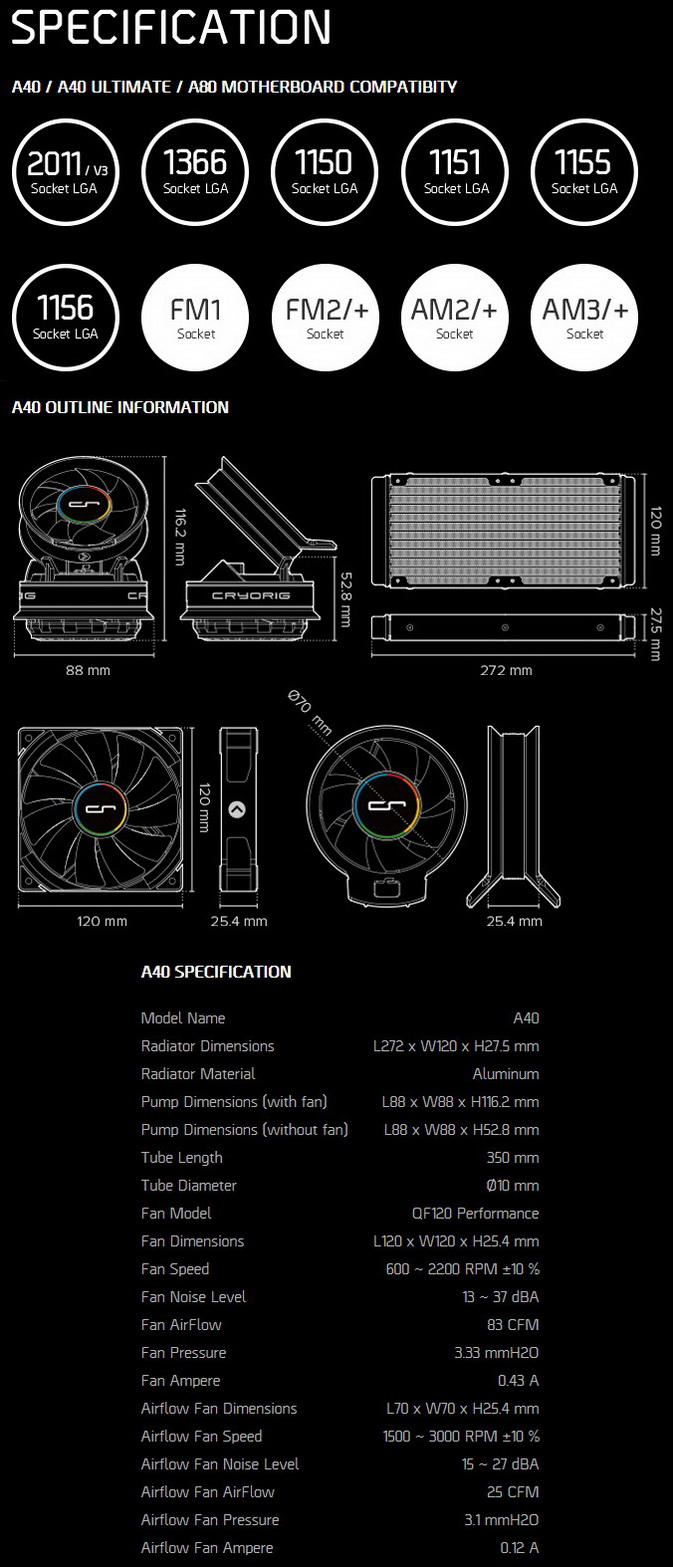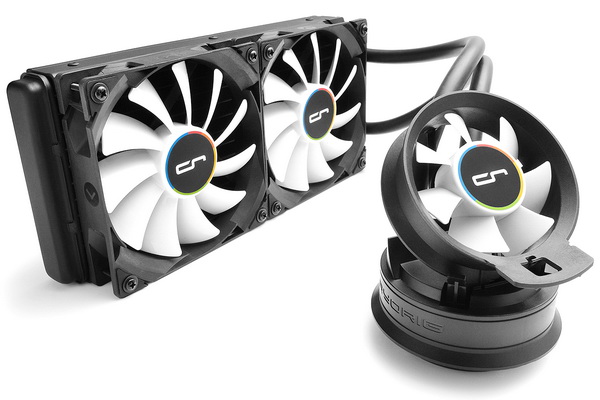INTRODUCTION
No matter how many times it crosses my mind i still can't believe the number of available CPU cooling solutions in the market today compared to just even 10 years ago (for me that's not a very long time). CPU air coolers and water cooling kits were around back then too (albeit in small numbers) but today thanks to the relatively new AIO liquid coolers consumers can get similar performance to that of a water cooling kit without having to spend much more than what they would for a high-end CPU air cooler (not to mention saving a good amount of interior space in the process). CRYORIG recently released their very own vision of what an AIO liquid CPU cooler should be like and after testing the top-of-the-line and very good A80 Hybrid Liquid Cooler roughly two months ago we just had to take a look at its more affordable and also slightly smaller brother the A40.
Officially founded in 2013, CRYORIG is a fresh new comer to the PC peripherals and Cooling market with a core team of seasoned veterans. The team’s resumes include experiences with renowned brands such as Thermalright, Prolimatech and Phanteks. The members are overclockers and PC modding enthusiasts, with a passion to strive for nothing but the best. With the long experience and drive for innovation and improvement, CRYORIG is about applying RESEARCH and innovative IDEAS making the coolest GEAR possible.
The A80 and A40 Hybrid Liquid Coolers are really not that much different since they are both dual fan models (the A80 is bundled with two 140mm fans whereas the A40 is bundled two 120mm fans) and feature the same pump and the same 70mm high-speed airflow fan. The difference of course has to do with the width and length of the aluminum radiator since the one used in the A80 measures 140/311mm while the one used in the A40 measures 120/272mm. I was a bit surprised to see that CRYORIG used the same thickness for both radiators (actually i was hoping for a thicker one when i reviewed the A80) but it seems that they're aiming at PC cases with not enough clearance space between the mainboard and the radiator mounting areas (not to mention they want more people to be able to use four fans in push and pull configuration). So let’s see how the A40 performs especially compared to its larger brother the A80.
SPECIFICATIONS AND FEATURES


PACKAGING AND CONTENTS
Once again the front of the box has a large product picture, the company logo and the main product features.
Moving on the left side we see CRYORIG "demonstrating" how the 70mm fan can help dissipate heat around the CPU area.
The complete product specifications and the compatible mainboard sockets are printed at the rear of the box.
Packaging is typical for such a product so no surprises here.
Along with the main body of the A40 contained in the box are also two QF120 Performance 120mm PWM fans, 70mm airflow fan, 8 fan mounting screws, product registration card, Intel/AMD installation guides, Intel/AMD backplates and all the necessary bits and pieces to install the unit onto Intel LGA1150/1151/1155/1156/1366/2011/2011-v3 and AMD AM2/AM2+/AM3/AM3+/FM1/FM2/FM2+ mainboards.
THE A40
Aside the slightly smaller radiator the A40 shares the same sized pump/waterblock combo.

Just like with the radiator used in the A80 the one used in the A40 has an FPI of 20.
Both PA (Polyamide) tubes are 10mm in diameter and 350mm long (just like the ones used with the A80).
With a diameter of 88mm the pump/base combo is the largest one we've seen with an AIO model and yes it’s the same one used with the A80.
Since the pump is not alone this time over you will need to use a SATA power connector as well as the 4pin PWM mainboard connector.
Unfortunately since the PA tubes go all the way inside the housing of the pump they can’t move left and right as much as in other AIO models.
The 70mm airflow fan can spin up to 3000RPM to produce up to 25CFM of airflow with up to 27dBA of noise.

The all-copper waterblock comes ready with a pre-applied layer of thermal conductive material.
The two QF120 performance 120mm PWM fans can spin up to 2200RPM to produce airflow levels of up to 83CFM with 37dBA of noise.
Once again CRYORIG has used fans that feature rubber pads/mounts on all 4 corners so you don't have to worry about vibrations making it to the radiator.
Well we're good to go so let’s see what CRYORIG has to offer with their A40 hybrid liquid cooler model.
TEST BED


TESTING METHODOLOGY
We always take things quite seriously when it comes to work so just like with the previous LGA1366 database we will not be testing each CPU Cooler on its own and with different ambient temperature levels and thus we can actually have yet another valid CPU Cooler database. Testing a CPU Cooler automatically means that you need to know where it stands against the immediate competition and to accomplish that we have spent both money and time through the years, something that we plan to continue to do so in order to get the most accurate results for the end consumers who read these lines. Every CPU cooler in this database is tested with the bundled 140mm/120mm/92mm/80mm fans while working at both idle speed and 100% of their speeds for all the temperature tests. CPU Coolers that do not come bundled with a fan/s are measured using a Noctua fan (size dependent on the model) to test for the temperature tests but due to the lack of a stock fan dBA level tests are obviously skipped. Single (120/140mm) watercooling solutions are tested with the radiator mounted at the rear of our test rig while dual/triple/quad (240/260/280/360/420/480/560mm) solutions with the radiator mounted at the top. For the dBA tests every cooler in the database was measured both while on idle mode or with the fan controller in the minimum setting and while on extreme load or with the fan controller all the way to the highest possible setting (PWM fans do that on their own without our intervention). Every single test takes place in a temperature controlled room of 23 degrees Celsius Ambient Temp with the help of two AC units placed diagonally inside the room. The Arctic Silver 5 thermal paste is used with every CPU Cooler in our latest LGA2011 database (although initially this was not the plan we had to change things to get the most accurate results). Finally it's very important to point out that just because a CPU Cooler is better than another when tested with our test rig that does not necessarily mean that the same performance differences will apply 100% for other CPU models and in other situations (such as different ambient temps and system configurations).
To successfully record the load temperatures we use the latest OCCT application for around 6-10 minutes to push the processor to its limits and after that is done and the temperatures are recorded we wait for about 10-20 minutes for the CPU to cool down and record the idle temperatures. This is done to allow time for the thermal conductive material to achieve the optimal performance level. Same procedure is then repeated with the Passmark BurnIn Test as a failsafe just in case the OCCT results are wrong. This procedure takes a lot more time than the usual peltier/thermometer tests but this way not only can we deliver real world results to our readers based on real CPUs but we can also triple check the results using a variety of programs. Last but not least the temperatures were recorded using both the latest versions of AIDA64 and RealTemp while the noise level tests are performed using a high precision ExTech HD600 Decibel Meter placed about 10-15cm above the CPU Cooler. Still although the same testing procedure applies to all units do take into consideration that unlike the official numbers which are measured in special noise isolated labs with just the fans here we also have both the rest of the cooler and the rest of the system (although all system fans are turned off when recording noise levels).
TEST RESULTS


CONCLUSION
When we finished our tests with the A80 Hybrid Liquid Cooling System the very first thing we thought about was just how much better it would be had CRYORIG used a thicker radiator like they did with the A40 Ultimate (perhaps an A80 Ultimate is on the way?). At the same time however we also wondered about just how its smaller brother the A40 would perform and as you can all tell from our charts it doesn’t fall that far behind. Unfortunately these good performance numbers come at a price since the two 120mm fans used are rather fast and thus louder compared to the 140mm ones used in the A80. Granted the difference between the A80 and the A40 is roughly 4dBA but it is there nonetheless so do take it into account. As for the 70mm fan once again we used a laser thermometer and recorded a good drop in temperatures around the CPU area but just like when reviewing the A80 we can’t really say whether or not this can improve overclocking and/or system stability.
CRYORIG may not have the most affordable products in the market today but with a current price tag set at USD104.35 inside the USA (Amazon.com) and at 103.50Euros inside the EU (Amazon.de) the A40 Hybrid Liquid Cooling System is priced just about right. There’s one problem however and that has to do with the A40 Ultimate and its thicker radiator (and thus better cooling performance) since that model costs just USD10/6Euros more compared to the A40. Of course not everyone will want a thicker radiator but for people with large enough PC cases this should be the obvious choice. That aside the A40 is yet another high-performance cooler by CRYORIG and although it doesn’t do well in terms of noise levels it’s still more than just good enough for our Golden Award.

PROS
- Build Quality
- Top Of The Charts Performance
- Thin Radiator (27.5mm)
- Up To 4 120mm Fans In Push & Pull
- Extra 70mm Radiator (CPU Socket Area Cooling)
- Easy Installation - Price (For Some)
CONS
- No Control Software
- Noise Levels

 O-Sense
O-Sense




























.png)

